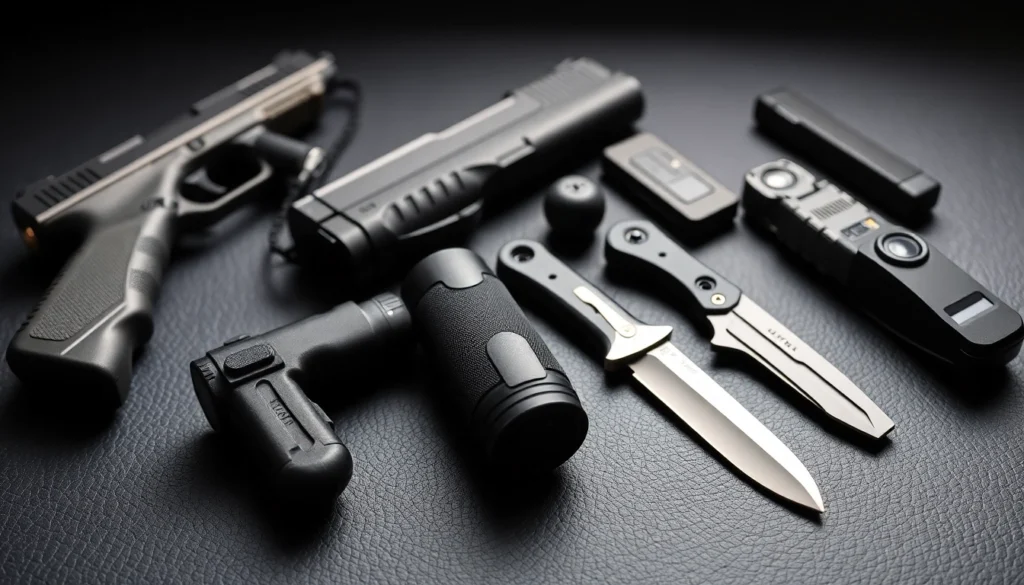Effective Self-Defense Weapons for Personal Security and Safety

Comprehensive Guide to Self-Defense Weapons: Safety, Selection, and Innovation
Ensuring personal safety in an increasingly unpredictable world has become a priority for many individuals. Self-defense weapons have evolved from traditional tools to sophisticated devices designed to provide protection, deter threats, and empower users with confidence. Whether you’re new to personal security or seeking to expand your arsenal, understanding the various types of self-defense weapons, their legal considerations, safe handling practices, and emerging technological advancements is vital. This comprehensive guide delves into the essential aspects of self-defense weapons, offering practical insights, expert recommendations, and up-to-date trends to help you make informed decisions and enhance your personal safety strategy.
For an extensive selection of self-defense tools tailored to different needs and legal standards, explore our dedicated Self-Defense Weapons page, where quality, legality, and reliability are prioritized.
Understanding Self-Defense Weapons and Their Legal Uses
Types of self-defense weapons available in the market
The range of self-defense weapons is broad, catering to various preferences, lifestyles, and legal restrictions. They are generally categorized into lethal and non-lethal options, with a clear emphasis on legality and effectiveness. Here’s a detailed overview:
- Batons: Often made of metal or reinforced plastic, batons are versatile and effective for close-range defense. They can be collapsible, making them discreet and portable, and serve as strong deterrents when wielded confidently.
- Knives and Blades: Folding knives or discreet fixed blades are common self-defense tools. Their legality varies significantly by jurisdiction, and proper training is critical to avoid accidental injury or legal repercussions.
- Pepper Spray and Chemical Agents: Non-lethal deterrents that incapacitate an attacker temporarily, providing an escape window. They are generally legal across states but regulations regarding potency and size may apply.
- Personal Alarms: Simple but effective devices emitting loud noises upon activation to draw attention and scare off attackers.
- Self-Defense Keychains and Discreet Devices: Innovative tools that combine functionality with concealment, such as kubotans, tactical pens, or disguised sprays.
- Electroshock Weapons (Stun Guns and Tasers): Devices delivering an electric shock to temporarily disable an attacker, requiring awareness of local laws for legal possession and use.
- Firearms: Legal in certain jurisdictions, firearms remain among the most effective self-defense weapons but necessitate comprehensive training and legal compliance.
Legal considerations for carrying self-defense weapons
The legality of self-defense weapons varies widely based on state, city, and national laws. For example,Self-Defense Weapons carrying items such as pepper spray or stun guns may require permits or be restricted altogether in some regions. Knives with blades exceeding a certain length might be prohibited, and some states restrict or outright ban firearms for personal defense without proper licensing.
It is critical to educate oneself about local laws before acquiring any self-defense tool. Resources such as official government websites or legal counsel can clarify permissible weapons, storage requirements, and restrictions. Violating these laws can lead to severe legal penalties, even if the intent was self-protection.
How to choose the right self-defense weapon for your needs
Selecting an appropriate self-defense weapon depends on various factors, including legal constraints, physical ability, environment, and personal comfort level. Key considerations include:
- Legal compliance: Ensure that the chosen weapon is legal in your jurisdiction.
- Ease of use: Opt for tools that you can operate confidently with minimal training.
- Portability: Your lifestyle dictates whether a compact pepper spray, a discreet keychain, or a full-sized baton suits your needs.
- Effective range: Consider whether your weapon needs to be close-range (knife, baton) or has a longer effective distance (pepper spray, tactical stun devices).
- Personal comfort and confidence: It’s essential to choose a weapon you feel comfortable handling, and always seek proper training to maximize safety and effectiveness.
Best Practices for Using Self-Defense Weapons Safely
Proper training and handling techniques
While possessing a self-defense weapon is crucial, knowing how to use it correctly is equally important. Proper training enhances confidence, reduces accidental injury, and ensures legal and effective deployment.
Many resources, including self-defense classes, online tutorials, and community workshops, offer comprehensive instruction. For example:
- Hands-on training for pepper spray application to ensure aim and distance management.
- Self-defense courses that include firearm proficiency, law understanding, and scenario-based exercises.
- Practice with stun guns or Tasers to understand how to activate and hold the device under stress.
Consider consulting certified self-defense instructors or agencies that specialize in personal safety training to improve handling skills and legal awareness.
Situational awareness and prevention strategies
Effective self-defense begins قبل any physical engagement. Situational awareness involves:
- Staying alert and attentive to your surroundings.
- Recognizing suspicious behavior early.
- Avoiding risky areas, especially at night or in secluded locations.
- Planning safe routes and informing trusted contacts of your whereabouts.
- Utilizing non-violent de-escalation techniques when possible.
Prevention reduces the likelihood of encounters where physical self-defense is necessary but remains a vital part of personal security.
Maintenance and safety tips for longevity and reliability
To ensure your self-defense weapons function properly when needed:
- Regularly test devices like alarms, stun guns, and pepper spray to confirm operational status.
- Safely store chemical agents in a cool, dry place, away from children and unauthorized persons.
- Replace sprays after their expiration date or if seals are broken.
- Charge or service electronic devices periodically, following manufacturer instructions.
- Clean and inspect mechanical components, such as baton joints, for wear and safety.
Comparing Non-Lethal Self-Defense Options
Pepper spray and chemical agents
Pepper spray remains among the most popular non-lethal self-defense tools due to its effectiveness and legal accessibility. It causes tears, coughing, and pain, giving the user crucial escape time. Advances have led to formulations with varying durations, spray distances, and formulations, including tear gas and psycho-chemical agents. For a secure choice, select sprays with the right range and potency, and always carry them in easily accessible locations.
Stun guns and tasers: effectiveness and legal limits
Stun guns and Tasers incapacitate attackers temporarily, providing a critical safety advantage. While they are highly effective, their legality varies; some states and countries require permits or outright restrict their possession. Proper training on their use is necessary, and they should be tested regularly. Modern models feature ergonomic designs, longer battery life, and safety switches, making them more user-friendly.
Personal alarms and tactical accessories for quick deployment
Personal alarms are simple devices that emit loud sounds to attract attention and ward off attackers. Tactical accessories like keychain sprays, discreet blades, or multipurpose flashlights further enhance safety. The key to their effectiveness lies in accessibility, ease of activation, and visibility—quick deployment is vital in high-stress situations.
Integrating Self-Defense Weapons into Personal Safety Plans
Creating a comprehensive safety toolkit
An effective personal safety plan combines multiple elements: self-defense weapons appropriate to your environment, situational awareness, and emergency contacts. Your toolkit might include pepper spray, a personal alarm, and a tactical flashlight. Keep your tools accessible, familiar, and regularly maintained. Consider carrying a backup or secondary device, such as a stun gun and a loud alarm, for layered protection.
Legal storage and concealment techniques
Proper storage entails keeping weapons in a secure, yet accessible, location. Concealment strategies vary—discreet holsters, keychains, or cleverly disguised accessories help prevent theft and accidental misuse. Always adhere to local legal standards regarding storage and concealment to avoid legal complications during an incident.
Personal self-defense training resources and community support
Engaging in self-defense courses and community groups enhances both skill and confidence. Many organizations offer training tailored for women, seniors, or specific environments like campuses. Participation offers practical experience, legal insights, and emotional resilience, which are all crucial in personal defense scenarios.
Emerging Trends and Innovative Self-Defense Weapon Technologies
Smart self-defense devices and electronic alarms
The grooming of integrated digital technologies has led to smart self-defense products. These devices can connect via Bluetooth to smartphones, providing GPS tracking, remote activation, and instant alerts to emergency services. Examples include electronic personal alarms with GPS, wearable panic buttons, and apps that record incidents for evidence.
Discreet and multi-purpose self-defense tools for women and seniors
Design innovation focuses on discretion and versatility. Discreet jewelry-like pepper sprays, tactical pens with built-in knives, and everyday objects like hair clips or scarves with hidden defense mechanisms serve dual purposes. These tools increase confidence among vulnerable populations without attracting unwanted attention.
Future developments in non-lethal personal security equipment
The future promises lighter, smarter, and more connected personal security devices. Technologies such as voice-activated alarms, biometric access control, and AI-powered threat detection are on the horizon. These advancements aim to enhance reliability, ease of use, and integration into daily lifestyles, making personal safety an accessible and seamless part of modern life.






